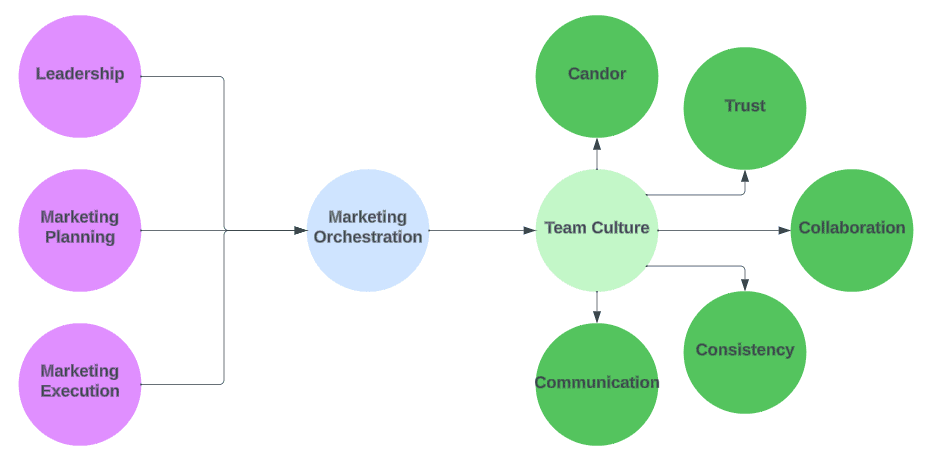Take Action Against Collaboration Drag

Summary
This article addresses "collaboration drag," a major revenue challenge for marketing and sales leaders and offers a three-part action plan—Fix the Foundation, Build Cross-Functional Systems, and Foster a Culture of Innovation. By tackling both systemic issues and individual mindsets, organizations can foster a collaborative environment, enhancing work quality and team relationships.
By Maria Geokezas, Chief Operating Officer at Heinz Marketing
Are you familiar with the idea of “collaboration drag?” It’s a term our President, Matt Heinz, uncovered recently, and it’s garnering a lot of attention among business leaders—for good reason.
Collaboration drag is a lot like playing the game of ‘telephone’ as kids. Everything starts well enough, but little by little, things go off course. And, in the end, no one can quite pinpoint the exact moment it all went wrong.
In the workplace, though, a breakdown in collaboration is more than an inconvenience; it’s one of the leading revenue killers for businesses.
In fact, businesses with a high level of collaboration drag are 37% less likely to hit their yearly revenue targets. That’s a significant hit to the bottom line, making it a critical issue for all marketing, sales, and customer success leaders.
By recognizing the symptoms of collaboration drag, businesses can begin to address the root causes and lay the foundation for improved collaboration in the future.
Symptoms and Root Causes of Collaboration Drag
The reasons for collaboration drag vary by organization. Sometimes, it’s as straightforward as needing a new change management process. Other times it’s more complex—such as an absence of shared organizational goals or cross-team conflict causing teams to withdraw into comfortable silos.
But whatever the cause, many of the symptoms look the same.
So, if you’re wondering whether or not your organization is suffering from collaboration drag, here are a few questions to ask yourself.
- Does essential information get trapped within individual teams, resulting in duplicate tasks or misaligned outcomes?
- Is communication slow and riddled with misunderstandings?
- Does everyone understand their roles and responsibilities for every project? Are tasks clearly defined?
- How often are project deadlines missed or almost missed because team members do not understand their responsibilities?
- Is team morale low? Are you experiencing higher-than-average turnover?
While these questions don’t address every symptom of collaboration drag, they represent a good starting point as they all reveal a breakdown in communication across teams.
If answering those questions made you realize your marketing, sales, and customer success teams aren’t working together as well as they could be. Let’s talk about how you can begin to fix the issue with a clear action plan.
Combatting Collaboration Drag
The good news is that collaboration drag can be resolved. By implementing a holistic strategy that tackles both systemic roadblocks and individual mindsets, you can cultivate a collaborative environment where everyone feels invested in the shared success of all initiatives.
This collective effort not only enhances the quality of work but also strengthens relationships and builds trust within teams, ultimately contributing to a more positive and productive environment.
Below is a simple three-part action plan you and your team can take and tailor to reduce collaboration drag across your organization.
Part 1: Fix the Foundation
- Identify bottlenecks within and across teams. Evaluate your current workflows to identify areas of inefficiency. Map your workflows, conduct surveys, and gather feedback to determine where collaboration drag is most evident.
- Clearly articulate the marketing, sales, and customer success teams’ roles and desired impact within the organization. Make everyone’s role clear by creating a concrete plan with measurable objectives and key performance indicators (KPIs).
- Communicate the plan effectively. Give everyone the “why” and “how” behind the marketing strategy to foster buy-in, alignment, and collaboration across teams.
Part 2: Build Cross-Functional Systems
- Embrace automation and technology. Use technology to your advantage. Automate routine tasks and streamline information sharing. Tools like project management platforms, workflow automation software, and communication platforms can make all the difference.
- Establish clear roles and responsibilities. Define ownership and accountability for every task in marketing initiatives. Defined roles eliminate confusion and finger-pointing, promoting smoother collaboration.
- Create cross-functional teams. Bring together representatives from different teams to develop shared objectives. Encourage joint problem-solving for more innovative solutions.
- Invest in communication and collaboration skills training. Equip team members with the skills to communicate effectively, actively listen, and navigate diverse perspectives—even if they don’t always agree with the outcome.
Part 3: Foster a Culture of Innovation and Improvement
- Promote a culture of experimentation. Encourage calculated risks, experimentation, and learning from failures. Establish an environment where new ideas can flourish.
- Empower decision-making. Empower team members to make their own decisions whenever possible. Show trust and confidence in your fellow team members’ abilities.
- Invest in professional development. Offer opportunities for team members to learn new skills and network with peers. 94% of employees reported that they’d stay at a company that delivered continued opportunities for development. Invest in employees’ goals as you want them to invest in the teams’ goals.
- Build a culture of continuous improvement. Regularly evaluate your processes and tools. Look at the data to determine if they’re still effective.
- Celebrate successes—big and small. Recognize and reward individual and team contributions to boost motivation. Celebrated small wins boost continued commitment, even when things get hard.
Overcoming collaboration drag requires diligence and continuous adaptation. It isn’t a problem you can solve overnight. Nor is there a one-and-done solution.
But when you create a workplace where your team feels heard, valued, and invested in the success of each project, collaboration happens naturally. By embracing the strategies outlined and working hard to build a collaborative, motivated, cross-functional team, you can set up your organization for years of future success.
Want to learn more about our Marketing Orchestration services and how to solve collaboration drag at your organization? Give us a shout at Acceleration@HeinzMarketing.com







